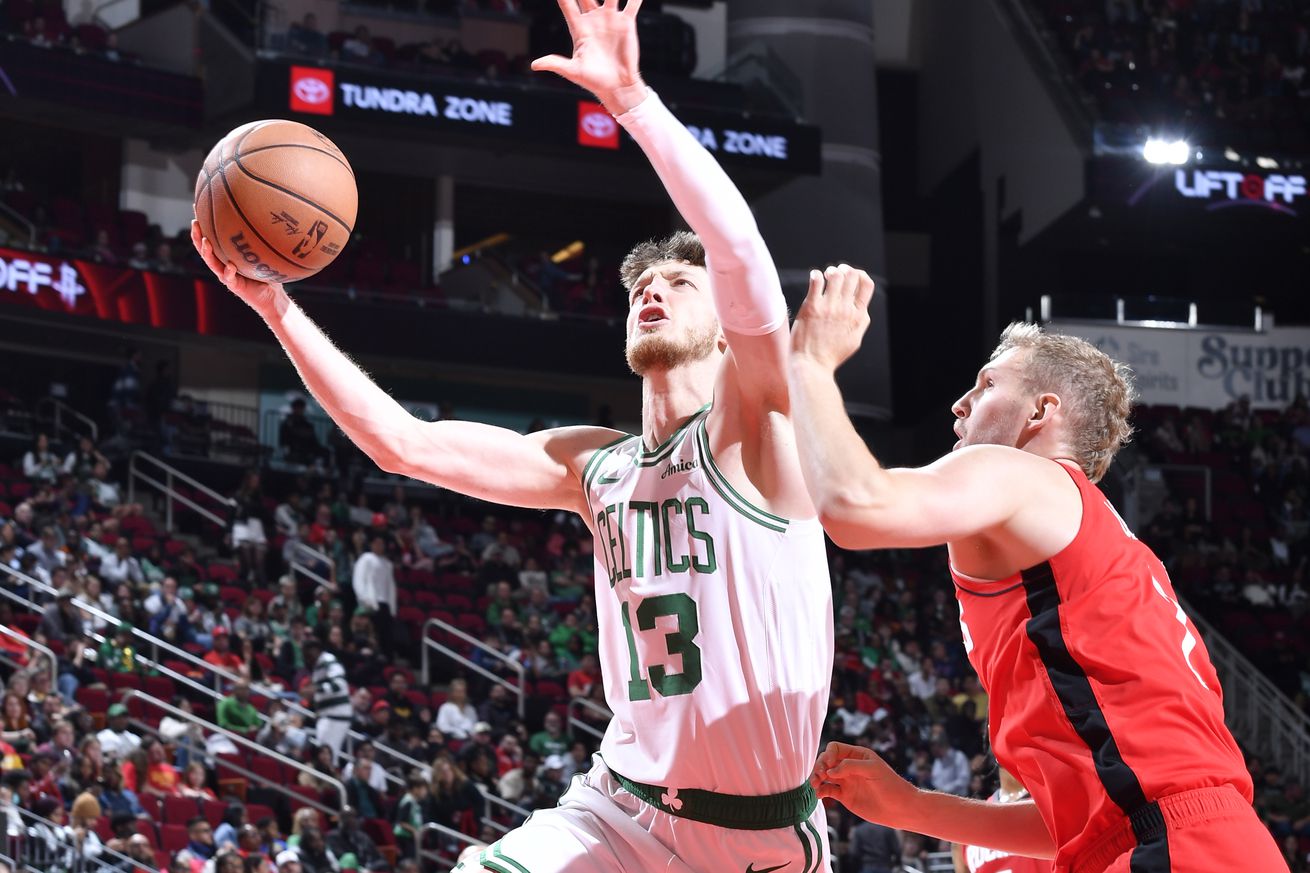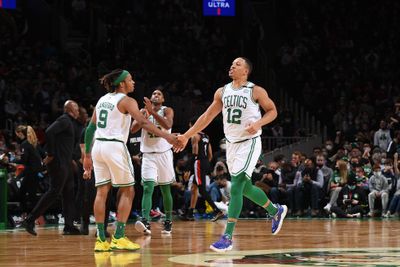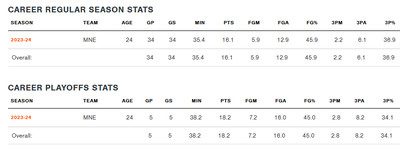
Why Drew Peterson should follow in the footsteps of Grant Williams.
Drew Peterson kind of reminds me of Grant Williams. And no, it’s not that their body types are nearly mirror images. It’s due to my concern about their ability to make their way in the NBA. Grant figured it out, and after watching Drew Peterson after he got some minutes, I’d bet he does, too.
I bring up Grant because there were points in his Celtics tenure where his NBA role wasn’t exactly obvious. Williams was a tweener defensively that didn’t have any clear offensive strengths at the NBA level. Did he have the size to match up with bigs? Was he quick enough to switch on the perimeter? Would his playmaking translate? What about his post-game? Would he ever make a three?
There’s a fine line for a role player between jack of all trades, master of none (think someone like Delon Wright who is decent enough defensively, can shoot a little and run a pick and roll), and not being good enough at any one skill to carve out a defined role. It’s a lot easier to find minutes for a player with defined strengths and weaknesses — the fit is more obvious. Brad Stevens did it with Evan Turner, a limited shooter but a plus playmaker with good size. Joe’s done it with Sam Hauser (easy mode since he’s an elite shooter) and Luke Kornet, who Joe has transformed into a rim protecting, glass crashing, hard rolling, plus passing big man despite coming into the league as primarily a floor spacer.

Photo by Brian Babineau/NBAE via Getty Images
We all know what happened with Grant. He was strong enough to handle big wings and small bigs, quick enough on the perimeter to (mostly) switch onto guards, and he learned to shoot. It all ended up in an NBA player that’s somewhere between low end starter and good bench player at the price of a $50 million contract.
Then you have guys like Romeo Langford. On paper, an athletic, ball-handling guard that was a solid on-ball defender and flashed some shooting potential. But Romeo was never able to really figure it out. He didn’t have any one skill that kept him on the floor. If the Cs needed shooting, there was someone else off the bench better than him. If they needed ball handling, there was someone else off the bench better than him. If they needed defense, there was someone else off the bench better than him. And subsequently, Langford is now out of the NBA.
Which brings us to Drew Peterson. Drew hasn’t exactly had a lot of opportunity to show out for the Celtics, but when’s he has played, I can’t help the wash of intrigue that comes over me. There’s something there, even if I haven’t quite put my finger on it yet.
Describing him in a vacuum makes him sound better than he actually is: he can shoot it a bit, handle it some, has good vision, understands the game, and isn’t a total and complete liability defensively. Wow, he can do everything on offense and isn’t bad defensively, that guy must be an All-Star, right?
Not quite. Just because Peterson possesses the theoretical ability to utilize these skills, doesn’t mean he regularly puts it into practice. I’m not sure Peterson will ever develop even one of these skills to an above average NBA level, but like Grant Williams in his rookie season, the flashes are there (and in Grant’s case, the defense was more than a flash in that season’s NBA Playoffs).
First things first, if Drew figures it out, he will be a totally different player from Grant. Grant first started earning minutes due to his defense and ability to make the right decision on offense. Peterson probably checks the latter box, but definitely not the former. His path to minutes is similarly obvious though: he needs to make shots.
Full disclosure: this is the portion of the program where I have to raise my hand and come clean. I have a pretty extreme bias against Peterson’s shooting, I hate his jumper. It’s fugly, but results are far more important, and Peterson has mostly gotten those.
From College Basketball Reference:

G-League:


This gives him a head-start on Grant, who didn’t flash consistent shooting until his second year, and he then really became a high-level shooter the years following. That’s great, and shooting alone can get you on the floor, but in Drew’s case, it probably won’t.
This is the part where I compare him to the other tall, shooting wing on the Celtics bench that gets targeted by opponents for a reason I’ll leave unmentioned. That is, of course, Xavier Tillman. Just kidding, Drew may have some similarities to Sam Hauser, but they are fundamentally different players.
The primary difference is Hauser’s shooting. Peterson can shoot; Hauser is one of the very best shooters in the league. There’re levels to this stuff, and Hauser is the final boss (Curry is the super-secret boss you don’t get until after you beat the game). Shooting at that high of a level can paper over a lot of warts, and luckily, Hauser has very few of them. Here’s Hauser’s college and NBA numbers to compare against Drew’s above:


Hauser has never shot lower than 40% for any full season, college or NBA. Drew shot over once, his penultimate college season at USC, and he hasn’t done so in the NBA or G-League (we don’t count the three NBA games from last season). But, and it’s an important “but,” he’s good enough to get guarded out there, and that’s step one to not submarining the offense.
To the point, Peterson is not a high enough level shooter for that to propel him to a role in and of itself, unlike Hauser. He’s got to bring something else.
The defense (it’s not actually that bad!)
In Grant’s case, that something else was stout, solid switchable defense (something Hauser is proficient at). For Drew, it probably won’t be defense, and by “probably,” I mean definitely. He’s simply not an impact defender, nor do I think he ever will be. The good news is that he’s also not a complete trainwreck. To me, he projects closer to “slightly below average” than “so bad it doesn’t matter how good he is on the other end of the court.”
Peterson’s biggest weakness defensively is his strength. This is something Hauser worked on, and can be somewhat remedied, but he simply doesn’t have the same wide, sturdy base that Hauser does.
On this drive and kick, Nikola Jovic muscles past him after the initial clean contact.
He’s only played real minutes in 3 games this season, but he’s not been targeted much. If he does become a more regularly part of the rotation, I expect there to be one on his back. He will need to get stronger to handle some of the wings he will be tasked with defending, and I expect teams will force him to switch onto their bigs. That concerns me, but it hasn’t been a problem yet.
He also doesn’t do a great job of impacting ball handlers from help positions. Most Celtics, and Tatum is especially good at this, would take a step and swipe towards Dru Smith on this play, just to make him feel his presence. Drew doesn’t move, at all.
You can’t leave the strongside corner shooter, but there is a line between leaving him to help and ignoring the ball handler entirely. Here’s another example.
While this is a weakness now, it’s eminently teachable, and I expect Peterson will catch on. The good news is that he’s not bad at moving his feet. He regularly stays in front of ball handlers, cuts off straight line drives, and at least forces them into pull-ups.
I’ve got my eye on you Mr. Peterson. pic.twitter.com/ddzhnh8dnk
— Wayne Spooney (@WSpooney) January 1, 2025
Been watching a lot of Drew Peterson defense. It’s not as bad as my initial live impressions. pic.twitter.com/KIz2qG7ome
— Wayne Spooney (@WSpooney) December 22, 2024
He executes the scheme and never really looks lost. He also hits the glass pretty hard and has good size for a wing, which is helpful. I have seen some tremendously bad defensive players in my 25 or so years of watching basketball, and Peterson is well above that level. That means Peterson’s future will be entirely decided by what he can do on the other end.
The interesting offense of Drew Peterson
We’ve already talked about the shooting with Peterson, and it’s good enough to get respected. That means most of his offense will come from spot up opportunities, but Peterson isn’t just a spot up guy. Probably his biggest strength as a player is his ability to put the ball on the floor for his size.
He’s got a decent first step and has some serious wiggle in his handle. He played on-ball as a creator a ton at USC, and that gives him a different dimension than someone like Hauser.
When teams close out on him, he’s competent putting it on the deck, attacking a defense, and making the correct read.
His vision and passing instincts are really good for a big wing.
Peterson knows where to be and how to play offense the way the Celtics want to. He registers an assist here due to some generous scorekeeping, but that’s not what stood out to me.
Drew makes two very quick decisions on this play that will help him find a role in Boston. First, he immediately moves the ball to Payton Pritchard who has an exploitable Jovic on him. Second, after he moves the ball, he quickly follows up the pass by getting into a screen for Pritchard. PP rejects it, but these are the types of little things that keep the Celtics’ offensive flotilla coasting forward. You absolutely cannot have paralysis by analysis and see the floor in Boston.
If Peterson’s shot continues to hold, he can use that as the base to build his offensive attack. Making the open ones, and punishing hard closeouts, is an easy way to contribute positively to an NBA offense. And if you are contributing positively on offense, and not a disaster on defense, that tends to lead to playing time.
Once he’s got that down, then we can see Peterson start to spread his wings a little bit and flash some of that handle and playmaking he showed in college. I don’t think Peterson will ever be some on-ball point forward like he was at times for USC, but those skills are useful, even for a guy that’s primarily deployed as a spacer.
So, like Grant Williams and Sam Hauser before him, Peterson has the tools to get himself onto the court and become a helpful piece of the Celtics’ rotation. With Hauser’s back and Horford’s age, there are minutes up for grabs, and it’s up to Peterson to snag them.